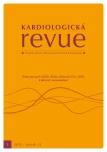Kidneys and acute coronary syndrome
Authors:
P. Widimský; I. Rychlík
Published in:
Kardiol Rev Int Med 2011, 13(1): 17-19
Category:
From Hypertension to Heart Failure
Overview
The introduction of percutaneous coronary intervention into the routine treatment of patients with acute coronary syndrome led to a major reduction in patient mortality, while at the same time leading to new problems. One of the main issues is serious parallel diseases – e.g. chronic kidney disease. Cardiorenal syndrome is an expression sometimes used to refer to the complex relationship between diseases of the heart and kidney. Obviously this is not a real syndrome, but a pathophysiological relationship. Patients with chronic kidney disease and acute coronary syndrome usually have a very widespread and advanced coronary atherosclerosis (mostly with massive calcification of the coronary arteries), which increases the risk and lowers the success rate of revascularisation procedures. This overview addresses several aspects of the relationship between chronic kidney disease and acute coronary syndrome, including the contrast of induced nephropathy.
Keywords:
acute coronary syndromes – chronic kidney disease – percutaneous coronary intervention – contrast agents
Sources
1. U.S. Renal Data System. USRDS 2008 Annual Data report: Atlas of Chronic Kidney Disease and End-Stage Renal Disease in the United States. Am J Kidney Dis 2009; 1: S1.
2. Ix JH, Shlipak MG, Liu HH et al. Association between renal insufficiency and inducible ischemia in patients with coronary artery disease: the heart and soul study. J Am Soc Nephrol 2003; 14: 3233–3238.
3. Al Suwaidi J, Reddan DN, Williams K et al. GUSTO-IIb, GUSTO-III, PURSUIT. Global Use of Strategies to Open Occluded Coronary Arteries. Platelet Glycoprotein IIb/IIIa in Unstable Angina: Receptor Suppression Using Integrilin Therapy; PARAGON-A Investigators. Platelet IIb/IIIa Antagonism for the Reduction of Acute coronary syndrome events in a Global Organization Network. Prognostic implications of abnormalities in renal function in patients with acute coronary syndromes. Circulation 2002; 106: 974–980.
4. Best PJ, Lennon R, Ting HH et al. The impact of renal insufficiency on clinical outcomes in patients undergoing percutaneous coronary interventions. J Am Coll Cardiol 2002; 39: 1113–1119.
5. Keith DS, Nichols GA, Gullion CM et al. Longitudinal follow-up and outcomes among a population with chronic kidney disease in a large managed care organization. Arch Intern Med 2004; 164: 659–663.
6. Sosnov J, Lessard D, Goldberg RJ et al. Differential symptoms of acute myocardial infarction in patients with kidney disease: a community-wide perspective. Am J Kidney Dis 2006; 47: 378–384.
7. Shlipak MG, Heidenreich PA, Noguchi H et al. Association of renal insufficiency with treatment and outcomes after myocardial infarction in elderly patients. Ann Intern Med 2002; 137: 555–562.
8. London G, Guérin AP, Marchais SJ et al. Arterial media calcification in end-stage renal disease: impact on all-cause and cardiovascular mortality. Nephrol Dial Transplant 2003; 18: 1731–1740.
9. Herzog CA. How to manage the renal patient with coronary heart disease: the agony and the ecstasy of opinion-based medicine. J Am Soc Nephrol 2003; 14: 2556–2572.
10. Herzog CA, Littrell K, Arko C et al. Clinical characteristics of dialysis patients with acute myocardial infarction in the United States: a collaborative project of the United States Renal Data System and the National Registry of Myocardial Infarction. Circulation 2007; 116: 1465–1472.
11. Bassand JP, Hamm CW, Ardissino D et al. Task Force for Diagnosis and Treatment of Non-ST-Segment Elevation Acute Coronary Syndromes of European Society of Cardiology. Guidelines for the diagnosis and treatment of non-ST-segment elevation acute coronary syndromes. Eur Heart J 2007; 28: 1598–1660.
12. Asif A, Epstein M. Prevention of radiocontrast--induced nephropathy. Am J Kidney Dis 2004; 44: 12.
13. McCullough PA. Contrast-Induced Acute Kidney Injury. J Am Coll Cardiol 2008; 51: 1419–1428.
14. Weisbord SD, Hartwig KC, Sonel AF et al. The incidence of clinically significant contrast-induced nephropathy following non-emergent coronary angiography. Catheter Cardiovasc Interv 2008; 71: 879–885.
15. Recio-Mayoral A, Chaparro M, Prado B et al. The reno-protective effect of hydration with sodium bicarbonate plus N-acetylcysteine in patients undergoing emergency percutaneous coronary intervention: the RENO study. J Am Coll Cardiol 2007; 49: 1283–1288.
16. Rudnick MR, Tumlin JA. Prevention of radiocontrast media-induced acute kidney injury. UpToDate in Nephrology and Hypertension. [www.uptodate.com] (last update Oct 16, 2008).
17. Mueller C, Buerkle G, Buettner HJ et al. Prevention of contrast media-associated nephropathy: randomized comparison of 2 hydration regiments in 1 620 patients undergoing coronary angioplasty. Arch Intern Med 2002; 162: 329.
18. Inrig JK, Patel UD, Briley LP et al. Mortality, kidney disease and cardiac procedures following acute coronary syndrome. Nephrol Dial Transplant 2008; 23: 934–940.
Labels
Paediatric cardiology Internal medicine Cardiac surgery CardiologyArticle was published in
Cardiology Review

2011 Issue 1
Most read in this issue
- Cardiogenic shock
- Is the prognosis of congestive heart failure patients still so bad?
- Mechanical ventricular support devices in heart failure treatment
- Latent obstruction in outflow tract of left ventricle in patient with hypertrophic cardiomyopathy
